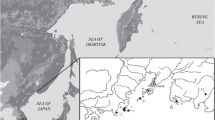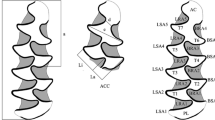Abstract
Research on the morphological variability of the occlusal surface of M1 talonid in the red foxVulpes vulpes (Linnaeus, 1758) in the Holarctic has been carried out on 2271 specimens originating from 42 populations. The Nearctic was represented by 666 specimens belonging to 13 populations, whereas Palearctic was represented by 1605 specimens from 29 populations. Analyses of the developmental level and formation of cristids between the hypoconid and entoconid allowed the differentiation of 34 shape variants of the occlusal surface of the talonid in the red fox. Because of the complicated variation of cristids, 34 variants were assigned to 5 morphotypes of group P. In the Palearctic and Nearctic a significant geographic variation occurred of P morphotypes and their variants. Primitive variants of the talonid structure on M1 are predominant in populations from the south of the Asian range of the red fox, while more progressive characters of the occlusal surface of the lower carnassial are typical of the northern and centrally located red fox populations in the Palearctic and Nearctic. The geographic differentiation is probably connected with different Pleistocene histories of particular populations.
Similar content being viewed by others
References
Baryshnikov G. F. and Potapova O. R. 1990. Variability of the dental system in badgers (Meles, Carnivora) of USSR fauna. Zoologicheskii Zhurnal 69: 84–97. [In Russian with English summary]
Baryshnikov G. F., Puzachenko A. Yu. and Abramov A. V. 2002. New analysis of variability of cheek teeth in Eurasian badgers (Carnivora, Mustelidae,Meles). Russian Journal of Theriology 1: 133–149.
Degerböl M. 1933. Danmarks pattedyr i fortiden i sammenligning med recente former. Vidensk. Meddr dansk naturh. Foren. 96: 353–641.
Fladerer F. A. and Reiner G. 1996. Evolutionary shifts in the first premolars pattern ofHypolagus beremendensis (Petényi, 1864) (Lagomorpha, Mammalia) in the Plio-Pleistocene of Central Europe. Acta Zoologica Cracoviensia 39: 147–160.
Goszczyński J. 1995. [Fox. A nature and game monograph]. Oikos, Warszawa: 1- 137. [In Polish]
Kurtén B. 1967. Some quantitative approaches to dental microevolution. Journal dental Research 46: 817–828.
Larivière S. and Pasitschniak-Arts M. 1996.Vulpes vulpes. Mammalian Species, 537: 1–11.
Lidicker Jr W. Z. 1991. Introduced mammals in California. [In: Biogeography of Mediterranean Invasions. R. H. Groves and F. di Castri, eds]. Cambridge University Press, Cambridge: 263–271.
Martyn D. 1985. [Climates of the world]. PWN, Warszawa: 1–668. [In Polish]
Nadachowski A. 1991. Systematics, geographic variation, and evolution of snow voles (Chionomys) based on dental characters. Acta Theriologica 36: 1–45.
Nadachowski A. 1992. Short-distance migration of Quaternary and recent mammals: a case study ofChionomys (Arvicolidae). Courier Forsch.-Inst. Senckenberg, 153: 221–228.
Pulliainen E., Rantanen A. V. and Salo L. J. 1972. On the carnassial tooth cusps in recent red foxes (Vulpes vulpes L.) in Finland and Denmark. Scandinavian Journal of Dental Research 80: 322–326.
Serdyuk V. A. 1979. Variability of tooth structure inCitellus parryi Rich. and possible ways of migration of this species in the north-east of the USSR. Zoologicheskii Zhurnal 58: 1692–1702. [In Russian with English summary]
Suchentrunk F. 2004. Phylogenetic relationships between Indian and Burmese hares (Lepus nigricollis andL. peguensis) inferred from epigenetic dental characters. Mammalian Biology 69: 28–45.
Suchentrunk F., Willing R. and Hartl G. B. 1994. Non-metrical polymorphism of the first lower premolar (P3) in Austrian brown hares (Lepus europaeus): a study on regional differentiation. Journal of Zoology, London 232: 79–91.
Szuma E. 2000. Variation and correlation patterns in the dentition of the red fox from Poland. Annales Zoologici Fennici 37: 113–127.
Szuma E. 2002. Dental polymorphism in a population of the red fox (Vulpes vulpes) from Poland. Journal of Zoology, London 256: 243–253.
Szuma E. 2003. Microevolutionary trends in the dentition of the Red fox (Vulpes vulpes). Journal of Zoological Systematics and Evolutionary Research 41: 47–56.
Tedford R. H., Taylor B. E. and Wang X. 1995. Phylogeny of the Caninae (Carnivora: Canidae): the living taxa. American Museum Novitates 3146: 1–37.
Van Valen L. M. 1994. Serial homology: the crests and cusps of mammalian teeth. Acta Palaentolologica Polonica 38: 145–158.
Wilson D. E. and Ruff S. (eds). 1999. Smithsonian Book of North American Mammals. Smithsonian Institution Press, Washington: 1–750.
Wolsan M. 1988. Morphological variations of the first upper molar in the genusMartes (Carnivora, Mustelidae). Mémoires du Muséum National d’Histoire Naturelle, Série C 53: 241–254.
Wolsan M. 1989. Dental polymorphism in the genusMartes (Carnivora: Mustelidae) and its evolutionary significance. Acta Theriologica 34: 545–593.
Wolsan M. 1993. Phylogeny and classification of early EuropeanMustelida (Mammalia: Carnivora). Acta Theriologica 38: 345–384.
Author information
Authors and Affiliations
Additional information
Associate Editor was Krzysztof Schmidt.
Rights and permissions
About this article
Cite this article
Szuma, E. Evolutionary implications of morphological variation in the lower carnassial of red foxVulpes vulpes . Acta Theriol 49, 433–447 (2004). https://doi.org/10.1007/BF03192588
Received:
Accepted:
Issue Date:
DOI: https://doi.org/10.1007/BF03192588




